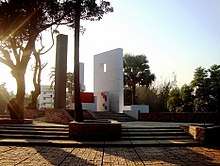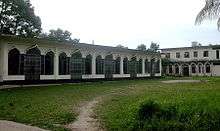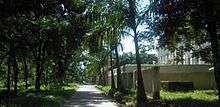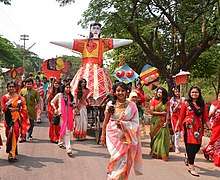Chittagong University of Engineering & Technology
Chittagong University of Engineering & Technology (Bengali: চট্টগ্রাম প্রকৌশল ও প্রযুক্তি বিশ্ববিদ্যালয়) commonly referred to as CUET (Bengali: চুয়েট), is a public engineering university in Bangladesh located in Raozan Upazila under Chittagong District. Established in 1968, this university is a government funded autonomous self degree awarding institution, maintaining special emphasis on teaching and research of engineering, technology, architecture and planning under five faculties and seventeen academic departments.
চট্টগ্রাম প্রকৌশল ও প্রযুক্তি বিশ্ববিদ্যালয় | |
 | |
Other name | CUET |
|---|---|
Former names | Engineering College, Chittagong (1968-1986) Bangladesh Institute of Technology, Chittagong (1986-2003) |
| Type | Public engineering university |
| Established |
|
| Affiliation | University Grants Commission, Institution of Engineers, Bangladesh, Bangladesh Institution of Planners |
| Chancellor | President of Bangladesh |
| Vice-Chancellor | Mohammad Rafiqul Alam[1] |
Academic staff | 200+ |
Administrative staff | 350+ |
| Students | 4,500[2] |
| Location | Pahartali, Raozan , , 22°27′43.50″N 91°58′22.60″E |
| Campus | Suburban, 188 acres (0.76 km2) |
| Language | English |
| Sports | Cricket, Football and Others |
| Website | www |
Number of present students including undergraduate, graduate and post-graduate is around 4500 with 900 students graduating each year.
Location

CUET is situated in the district of Chittagong under Chittagong Division. It is in the Pahartali union under Raozan sub-district, by the north side of the Chittagong-Kaptai road about 20 kilometers from the center of Chittagong. The 420 Megawatt Raozan Thermal Power Plant is situated opposite to the campus. Karnaphuli Hydroelectric Power Station, the largest source of hydroelectricity of the country, is situated in Kaptai, about 25 kilometers from CUET.[3][4]
History

To meet the increasing demand of professional engineers for the national development, the National Economic Council of the Government of Pakistan decided to establish The Engineering College, Chittagong on August 28, 1962. The Engineering College, Chittagong, started functioning on December 28, 1968, by admitting 120 students in its first academic session under the faculty of Engineering, University of Chittagong. On 1 July 1986, through a Government Ordinance (No. XXI, 1986) the college was converted into an autonomous institution called Bangladesh Institute of Technology (BIT), Chittagong. There were three other similar BITs in Khulna, Rajshahi and Dhaka. The President of Bangladesh was the visitor of these institutes. A Board of Governors headed by a Chairman appointed by the President was the policy-making and administrative authority which had its head office at Tejgaon, Dhaka. Though the BIT, Chittagong was said to be an autonomous institution there was various complexity in the administration, control, budget, admission, development and other processes of the institution. On September 1, 2003, it was a historic moment when the BIT, Chittagong was converted into a fully autonomous public university & named Chittagong University of Engineering and Technology or CUET for short, after the teachers and students of BIT, Chittagong started huge movement demanding university status for all four BITs.[5] The honorable President of Bangladesh is the Chancellor of the University. BIT, Khulna; BIT, Rajshahi and BIT, Dhaka have been converted to Khulna University of Engineering and Technology (KUET), Rajshahi University of Engineering and Technology (RUET), and Dhaka University of Engineering and Technology (DUET) respectively.[4]
At present, the university is a fully autonomous statutory organization of the Government of Bangladesh which awards degrees itself to the graduates. There are various statutory bodies like syndicate, academic council, finance committee, planning, and development committee, academic committees, etc. for policy and decision-making on aspects of the university under the framework of the Act.
Campus
The university campus covers an area of 188 Acres. The campus of CUET is landscaped around a valley with hilly areas and plant varieties making the campus a natural arboretum. Facilities include academic buildings, administration building, auditorium, library, computer center, workshop, research laboratories, halls of residence, teachers' quarter, canteens and central mosque. The university has inside its boundaries a bank, a post office, three canteens, a DRMASS telephone exchange, two card-phone booths, a PABX, a phone and fax caterer, a large auditorium, two galleries for holding conference, a two-storied central mosque having a floor area of 560 square meters, and two mini-mart for general needs.

Medical Center
The University Medical Center is equipped for primary care, quarantine, sickbed exam appearance, few diagnostics but serious cases are referred to a local hospital 10 kilometers away or to the city hospital. Presently Medical Center has been planned for an upgrade by building size equipment and health care stuff.
Transportation
The university runs its own regular bus service to and from the city for benefit of the students residing there, every office day. Friday is weekly holiday. Currently 10 buses are available for students and staffs of the university.
Sports and entertainment
The university provides facilities for football, hockey, cricket, volleyball, basketball, table tennis etc. The students play tennis, badminton and other games as well. Sports meets and games competitions are features of campus life. The students arrange debate, cultural show, indoor games competition etc.
Library
There are two libraries in CUET. Multiple copies of textbooks are available. The library has more than 52,000 books and thousands of journals and periodicals in its collection. The old library stands in the center of CUET campus. It is used for book lending. The new library stands beside Civil Building. Approximately 200 students can use these facilities at a time. The daily newspaper and monthly magazines are available.
University School and College
CUET has a university school and college named Chittagong Engineering University School and College inside its campus, intended to provide secondary and higher secondary education for the children of university staffs which also receives general students.
Administration
Chancellor
Vice-Chancellor
- Prof. Dr. Mohammad Rafiqul Alam
Registrar
- Prof. Dr. Faruque-Uz-Zaman Chowdhury (Additional Charge)
Academics
Academic programs
The university offers degrees in engineering disciplines in undergraduate and post-graduate levels and also conducts research and provides degrees in basic sciences in post-graduate level.
| Name of Faculties | Departments | Abbrev. | Undergraduate | Graduate | Postgraduate |
|---|---|---|---|---|---|
| Faculty of Electrical & Computer Engineering |
Electrical and Electronic Engineering | EEE | |||
| Computer Science and Engineering | CSE | ||||
|
Electronic & Telecommunication Engineering |
ETE | ||||
| Biomedical engineering | BME | ||||
| Faculty of Civil Engineering |
Civil Engineering | CE | |||
| Water Resources Engineering | WRE | ||||
| DEE | |||||
| Faculty of Mechanical Engineering |
Mechanical Engineering | ME | |||
| Petroleum & Mining Engineering | PME | ||||
| MIE | |||||
| Faculty of Architecture & Planning |
Architecture | ARCH | |||
| Urban & Regional Planning | URP | ||||
|
HUM |
|||||
| Faculty of Engineering & Technology |
Physics | PHY | |||
| Mathematics | MATH | ||||
|
CHEM |
|||||
| Material Science and Engineering | MSE | ||||
| Nuclear Engineering | NE |
Institutes and centers
| Institutes | Centers | ||
|---|---|---|---|
| Name of Institutes | Abbrev. | Name of Centers | Abbrev. |
| Institute of Information and Communication Technology | IICT | Center for River, Harbor and Landslide Research | CRHLSR |
| Institution of Energy Technology | IET | Center for Industrial Problems Research | CIPR |
| Directorate of Research and Extension | DRE | Center for Environmental Science and Engineering | CESE |
| Institute of Earthquake Engineering Research | IEER | Language Center | LC |
Rankings
According to the Webometrics Ranking of World Universities (also known as Ranking Web of Universities), CUET was ranked 11th among universities in Bangladesh and 1297th among continental universities in January 2019.[6]
Research and publication
The university has a motto to make itself as 'A center of excellence'. For promoting research, the university established a distinct institute namely 'Research and Extension'. International Conferences organized by CUET: International Conference on Advances in Civil Engineering (ICACE)[7] organized by Department of Civil Engineering, CUET International Conference on Mechanical Engineering and Renewable Energy (ICMERE)[8] organized by Department of Mechanical Engineering, CUET International Conference on Electrical, Computer and Communication Engineering (ECCE)[9] organized by faculty of Electrical and Computer Engineering (ECE)
Academic calendar
After the publication of admission test result, selected students are admitted in Level-1 (academic year). Each Level is divided into three terms. Term-I and Term-II are composed of 18 weeks and Short Term composed of 3 weeks. Each week consists of five working days. A student can register for the next Level after completion of all three Terms. A Bachelor course in Engineering consists of four Levels and a Bachelor of Architecture course consists of five Levels. A Term final examination is held at the end of Term-I and II besides class tests examination for continuous assessment of progress.
Students can clear any backlog or incomplete courses in the Short Term exam. At least 155 credit hours must be earned to be eligible for a bachelor's degree in Engineering. The candidate is awarded Honors if he/she obtains CGPA above 3.75 or higher and awarded Chancellor's award if CGPA is 4.0.
Medium of Instruction
The language of instruction is English, which is the official language for examinations.
Admissions
The Undergraduate admission test is one of the most intensive written examinations in Bangladesh. After completion of higher secondary education or A level, a student can submit her or his application for undergraduate admission if he/she fulfills the minimum requirements. Students with the best grades in Mathematics, Physics, and Chemistry of their higher secondary examination are allowed to sit in the admission test. The screening process allows 10,000 students to sit for the admission test, based on the cumulative sum of grade points in these four subjects. Students have to sit only for the written test in admission. They have to seat for an additional free-hand drawing test in order to get admitted in architecture. After the admission test, only about 890 students get admitted.[10] However, for admission to MS and PhD programs candidates are required to appear in interviews and/or written tests.
Expenses
It is one of the public universities of The People's Republic of Bangladesh. The major part of the expense is subsidized by the government through University Grants Commission. A little amount of total expense like hall dues and registration fees per semester is to be paid by the Bangladeshi students. For international students, $500 is to be paid per semester as registration fees. The university also provides scholarship on the basis of their merit.[11]
ICT incubator
The Bangladesh Hi-Tech Park Authority (BHTPA) is building country's first ICT incubator in Chittagong University of Engineering and Technology.[12] The officials from the Ministry of Communication Technology and BHTPA selected a section of land of about 25 acres inside the university campus.[12] On 21 November 2013, BHTPA inaugurated the office of the ICT Business incubator in CUET campus.[13] The project was approved by the economic department of BHTPA on 8 November 2012.[12]
Halls of residence

There are five men's and two women's dormitories.
| Male Dormitories | Total | Female Dormitories | Total |
|---|---|---|---|
| Shaheed Mohammad Shah Hall | 5 | Sufia Kamal hall | 2 |
| Dr. Qudrat-E-Khuda Hall | |||
| Bangabandhu hall | Begum Shamsunnahar Hall | ||
| Shaheed Tareq Huda Hall | |||
| Sheikh Rasel Hall |
Student organizations

- ASME CUET Student Chapter
- CSME CUET Chapter - The Canadian Society for Mechanical Engineering
- CUET Computer Club
- IEEE CUET Chapter
- ACI Student Chapter - CUET (American Concrete Institute)
- Robo Mechatronics Association (RMA), CUET
- Andromeda Space and Robotics Research Organization (ASRRO), CUET
- Astronomy Society of CUET
- CUET Sports Club
- Green for Peace, CUET
- Joyoddhoney, CUET
- CUET Photographic Society
- CUET Debating Society
- CUET Career Club
- CUET Higher Study Society
- Bangladesh Students' League, CUET Unit
- Bangladesh Students' Union (CUET unit)
- CUET Journalist Association
- ESAB CUET Unit Face
- CUET SPE Student Chapter
- House of Language & Literature, CUET
- CUET MUN Club
- CUET CAD Society
- CUET Film Society
- CUET Adventure Society
- CUET Research & Innovation Club
- CUET Supply Chain Society
See also
- Bangladesh University of Engineering and Technology
- University of Dhaka
- Dhaka University of Engineering & Technology
- Khulna University of Engineering & Technology
- Rajshahi University of Engineering & Technology
- List of Universities in Bangladesh
References
- "Message from VC". Cuet.ac.bd. Retrieved 3 March 2019.
- "CUET - At a Glance". Cuet.ac.bd. Retrieved 27 October 2015.
- Undergraduate Bulletin, EEE 2012
- "History of CUET". CUET. Retrieved 16 June 2015.
- "PM welcomed for upgrading Ctg BIT to CUET". The Independent. Dhaka. 13 March 2002. Archived from the original on 29 March 2015. Retrieved 30 November 2014 – via HighBeam Research.
- "University - Ranking Web of Universities: More than 28000 institutions ranked". Webometrics.info. Retrieved 3 March 2019.
- "Welcome to ICACE-2018". Cuet.ac.bd. Retrieved 3 March 2019.
- "Welcome to ICMERE 2017". Cuet.ac.bd. Retrieved 3 March 2019.
- "Welcome to ECCE-2019". Cuet.ac.bd. Retrieved 3 March 2019.
- "Admission Prospectus" (PDF). CUET (in Bengali). Archived from the original (PDF) on 2016-03-03. Retrieved 2013-06-26.
- Undergraduate Bulletin, Dept. of EEE p. 24
- "Hi-Tech Park Authority Bangladesh: Project". Hi-Tech Park Authority Bangladesh. Archived from the original on 18 July 2013.
- চুয়েটে হচ্ছে তথ্যপ্রযুক্তি ব্যবসার ইনকিউবেটর [CUET the IT business incubator]. Prothom Alo (in Bengali). 24 November 2013. Retrieved 16 June 2015.